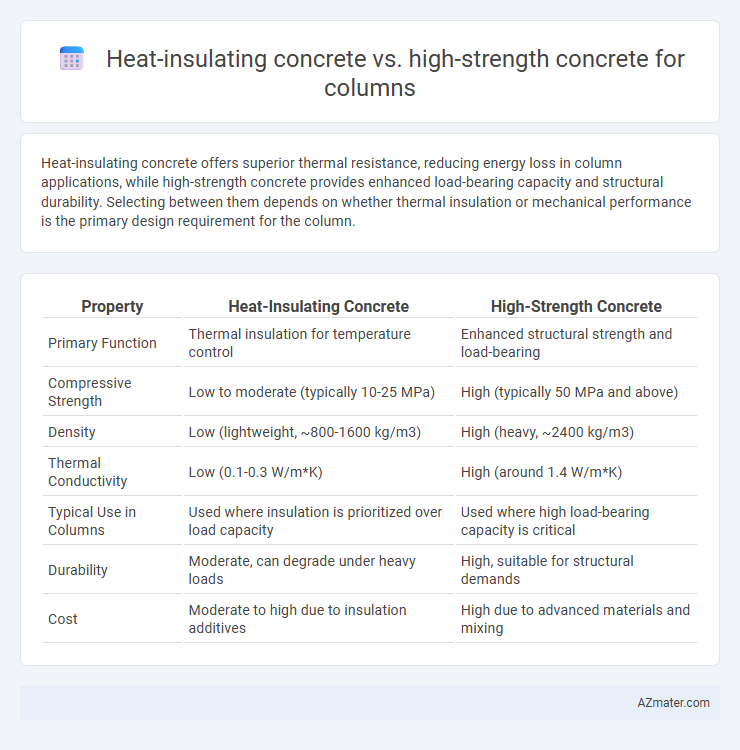Heat-insulating concrete offers superior thermal resistance, reducing energy loss in column applications, while high-strength concrete provides enhanced load-bearing capacity and structural durability. Selecting between them depends on whether thermal insulation or mechanical performance is the primary design requirement for the column.
Table of Comparison
| Property | Heat-Insulating Concrete | High-Strength Concrete |
|---|---|---|
| Primary Function | Thermal insulation for temperature control | Enhanced structural strength and load-bearing |
| Compressive Strength | Low to moderate (typically 10-25 MPa) | High (typically 50 MPa and above) |
| Density | Low (lightweight, ~800-1600 kg/m3) | High (heavy, ~2400 kg/m3) |
| Thermal Conductivity | Low (0.1-0.3 W/m*K) | High (around 1.4 W/m*K) |
| Typical Use in Columns | Used where insulation is prioritized over load capacity | Used where high load-bearing capacity is critical |
| Durability | Moderate, can degrade under heavy loads | High, suitable for structural demands |
| Cost | Moderate to high due to insulation additives | High due to advanced materials and mixing |
Introduction to Concrete Column Types
Heat-insulating concrete columns incorporate materials like aerated concrete or expanded polystyrene to enhance thermal resistance, reducing energy loss in buildings. High-strength concrete columns utilize advanced mix designs with low water-cement ratios and supplementary cementitious materials to achieve compressive strengths above 6,000 psi, supporting greater structural loads and slender designs. Selecting between heat-insulating and high-strength concrete depends on balancing thermal performance requirements and load-bearing capacity in column design.
Overview of Heat-Insulating Concrete
Heat-insulating concrete offers superior thermal resistance and reduced heat conductivity, making it ideal for applications where temperature regulation is critical, such as industrial and energy-efficient buildings. Its composition typically includes lightweight aggregates and insulating additives that enhance thermal performance without compromising structural integrity. High-strength concrete, while optimized for compressive strength and load-bearing capacity, generally lacks the thermal insulation properties found in heat-insulating concrete, making it less suitable for applications prioritizing heat retention or dissipation.
Key Features of High-Strength Concrete
High-strength concrete used for columns typically exhibits compressive strengths greater than 6000 psi (41 MPa), offering exceptional load-bearing capacity and enhanced durability under structural stress. Its dense microstructure reduces permeability, improving resistance to environmental factors like freeze-thaw cycles and chemical attack. Unlike heat-insulating concrete, high-strength concrete prioritizes mechanical performance and long-term stability in critical load-supporting applications.
Thermal Efficiency in Structural Columns
Heat-insulating concrete enhances thermal efficiency in structural columns by significantly reducing heat transfer through its low thermal conductivity, which helps maintain internal temperature stability in buildings. High-strength concrete, while offering superior load-bearing capacity, generally exhibits higher thermal conductivity, resulting in less effective insulation performance compared to heat-insulating variants. Optimizing column design for thermal efficiency prioritizes heat-insulating concrete materials that balance structural support with improved energy conservation in building envelopes.
Load-Bearing Capabilities Comparison
Heat-insulating concrete typically features lightweight aggregates and air voids, resulting in lower compressive strength compared to high-strength concrete, which is engineered with dense aggregates and optimized mix designs to achieve compressive strengths exceeding 60 MPa. High-strength concrete significantly enhances the load-bearing capacity of columns, enabling support for greater axial loads and improved structural performance under high-stress conditions. In contrast, heat-insulating concrete prioritizes thermal resistance, making it suitable for non-structural or lightly loaded column applications where insulation is critical but load-bearing demands are moderate.
Energy Savings and Sustainability
Heat-insulating concrete significantly enhances energy savings by reducing thermal conductivity in building columns, leading to lower HVAC energy consumption and improved indoor temperature regulation. High-strength concrete, while primarily designed for structural durability and load-bearing capacity, contributes to sustainability by allowing for slimmer, more material-efficient columns, reducing overall resource use. Combining these materials optimizes energy efficiency and structural performance, promoting sustainable construction practices in modern architecture.
Durability and Service Life Considerations
Heat-insulating concrete offers superior thermal resistance, reducing temperature-induced stress and enhancing durability in columns exposed to extreme temperature variations. High-strength concrete provides enhanced load-bearing capacity and improved resistance to mechanical stresses, which can extend service life in structural applications subjected to heavy loads. Selecting between these concretes depends on whether thermal insulation or structural strength is prioritized, as heat-insulating concrete excels in thermal durability while high-strength concrete ensures prolonged service life under mechanical stress.
Cost Analysis and Economic Impact
Heat-insulating concrete typically incurs higher initial costs due to specialized materials like aerated additives and insulating aggregates, but offsets expenses by reducing energy costs in building operation through improved thermal performance. High-strength concrete, while generally more expensive per cubic meter than standard concrete, offers significant structural benefits that can reduce material quantities and labor in column construction, leading to potential savings in foundation size and reinforcement requirements. Evaluating cost-effectiveness depends on project priorities; heat-insulating concrete provides long-term operational savings, whereas high-strength concrete delivers immediate structural efficiency, making their economic impact context-specific based on energy prices and structural demands.
Suitability for Different Building Projects
Heat-insulating concrete excels in energy-efficient building projects by providing superior thermal resistance, making it ideal for residential and commercial structures aiming to reduce heating and cooling costs. High-strength concrete is preferred for high-rise buildings and infrastructure projects requiring enhanced load-bearing capacity and durability under extreme stress conditions. Choosing between these concretes depends on project priorities: thermal insulation needs favor heat-insulating concrete, while structural integrity and strength demands necessitate high-strength concrete for columns.
Conclusion: Choosing the Right Concrete for Columns
Heat-insulating concrete provides superior thermal resistance, making it ideal for columns in structures requiring energy efficiency and temperature regulation. High-strength concrete offers enhanced load-bearing capacity and durability, suitable for columns subjected to heavy structural demands. Selecting the right concrete depends on balancing thermal performance needs and structural strength requirements specific to the building design.

Infographic: Heat-insulating concrete vs High-strength concrete for Column
 azmater.com
azmater.com